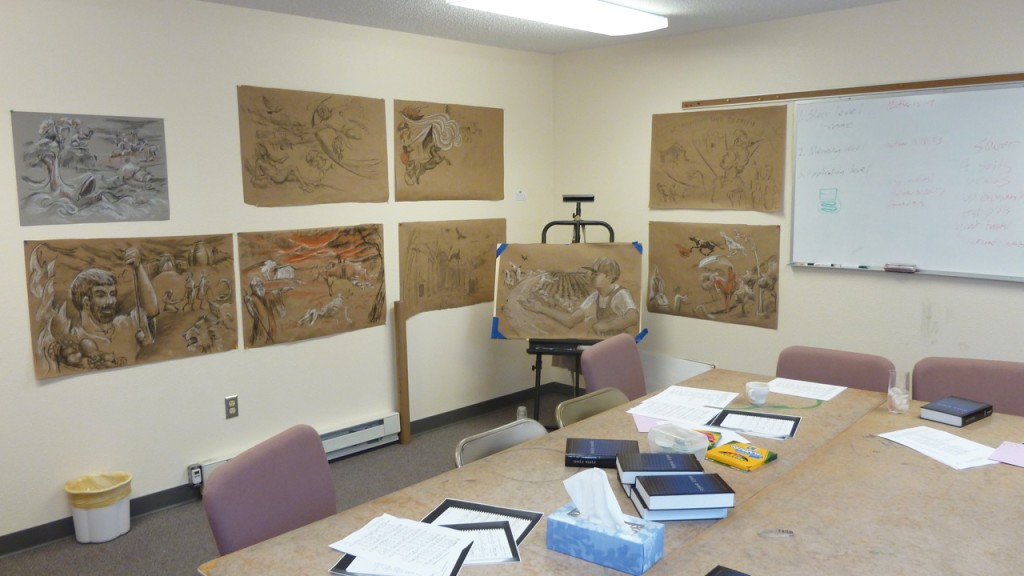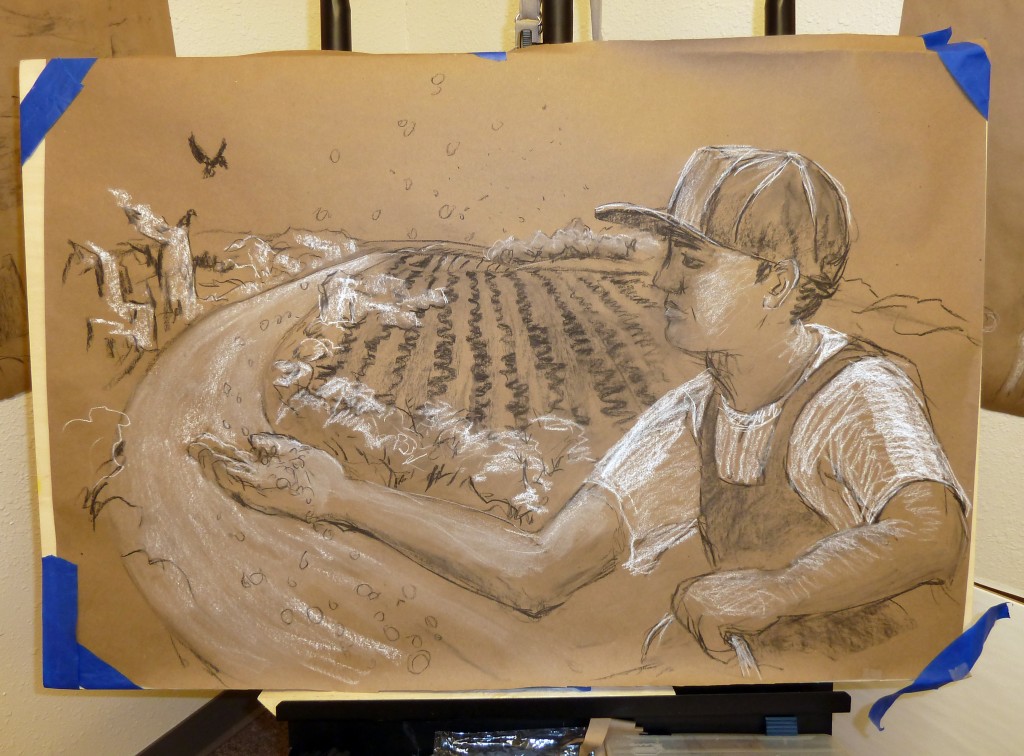Jesus proclaimed the Good News with dramatic stories drawn from the stuff of everyday life: planting, baking, tending livestock, fishing, weddings, family conflict, crime. I’m starting a series of posts on our Sunday school class about these stories—the Parables of Jesus.
Building on our Minor Prophets class, we designed the Parables class to include both art and music. Naomi Friend returned as our artist-in-residence and James Slegers became our musical director.
We also moved into a new class room, which we decorated with Naomi’s Minor Prophets art.
I’ll make a separate post about how we organized the class, but what I’m going to do in each parable post is to say a bit about the parable, share Naomi’s drawing, link to other artwork based on the parable, and list the songs we sang.
The Kingdom Parables in Matthew 13 (at the center of the book) are one of the highlights of Jesus’ teaching: seven stories he uses to describe the Kingdom of God. The Parable of the Sower is about hearing the message of the Kingdom, describing four different responses to the message—each represented by the outcome of seed scattered by a farmer—and ending with the admonition “Whoever has ears, let them hear.” In the language of the parable: be good soil.
The parable is one of only two with a title given in the text and one of only three that Jesus explains. Jesus also uses the parable, in response to a question from the disciples, to explain why he teaches in parables. Quoting Isaiah 6, Jesus predicts that his proclamation of the Kingdom will result in hardened hearts, but tells the disciples they are blessed by their hearing.
I’m struck by the generosity of the sower. He scatters the seed widely, not just in places where it seems likely it will take root, but also in places where it seems unlikely to. He displays a patience like that seen in the Parable of the Wheat and Weeds, which also features a farmer willing to wait for harvest.
Naomi’s depicts the sower as a contemporary farmer in overalls and a ball cap, but sowing seed by hand. He sows on a path (with birds), stony places (at far left), thorns, and good soil. As always, Naomi made her drawing during during our hour-long class in dialogue with class members.
More art
During each class, we also looked at other parables artwork. Here are some best examples I found online:
- Pieter Bruegel. Parable of the Sower (1557).
- Abel Grimmer. The Parable of the Sower (1596).
- James B. Janknegt. Four Soils (2000).
- Reinhold Marxhausen. The Sower (c. 1973).
- Edward Knippers. The Sower (2004).
- Christina Ramos. Parable of the Sower (2009).
- Miki De Goodaboom. The Parable of the Sower (2010).
- Lisa Snow Lady. The Parable of the Sower (2010).
- DeLynn Coppoletti. Parable of the Sower (2010).
- Ryan Jackson. The Sower and the Seeds (2010).
Nine more examples of Sower artwork can be found at Sacred Art Meditations.
Music
Each week in our class we sang songs related to the parable. Many of these are from And Jesus Said: Parables in Song (Sela Publishing), which contains 55 songs based on parables. A second good source is the CRC/Faith Alive hymnal Singing the New Testament, which contains songs based on various New Testament passages.
The two Sower songs we sang were “Where Is the Kingdom” (AJS #1) and “Lord, Let My Heart Be Good Soil” (SNC #79).
“Lord, Let My Heart Be Good Soil,” a 2002 hymn by Handt Hanson, can be found in Sing! A New Creation. (The tune is here.) The song is a prayer that our own hearts will be like the good soil of the parable:
Lord, let my heart be good soil,
open to the seed of your Word.
Lord, let my heart be good soil,
where love can grow and peace is understood.
“Where Is the Kingdom” is the opening song in And Jesus Said and contains references to around a dozen parables. It’s set to the tune of BUNESSAN (“Morning Has Broken”). We used it regularly as an opening song for the class. (And Jesus Said includes five other Parable of the Sower songs so there are plenty to choose from.)
Up next: More Kingdom Parables from Matthew 13—The Parables of the Mustard Seed and the Yeast.

